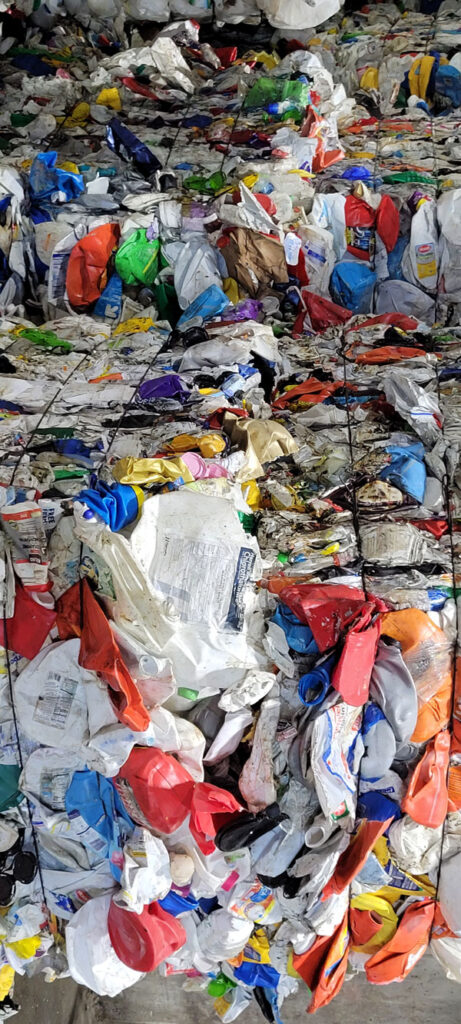solid waste 101

Plastic
Plastics are relative newcomers to municipal solid waste, as they have come into common use for consumer products since the 1950s. Manufactured from oil or natural gas, plastics are desirable for manufacturing because they are durable, lightweight, versatile, water resistant, and relatively inexpensive to manufacture.
However, plastics are not biodegradable, which presents a major challenge for solid waste management. While some plastics in the waste stream are incinerated or recycled, the vast majority of this material is disposed of in landfills. The Environmental Protection Agency estimated that in 2018, approximately 16% of plastics in the U.S. waste stream was incinerated and less than 9% was recycled.
Once in a landfill, plastics can take hundreds of years to biodegrade. Estimates range from 10 to 100 years for plastic bags to between 500 and 1,000 years for more durable items. The useful life of most plastic products, especially of single use items, is miniscule compared to the length of their life in a landfill.
Recycling plastics is difficult, expensive, energy-intensive, and in some cases impossible. Reducing the use of plastics by replacing single use plastics with multiple use items and replacing plastic packaging with materials that are biodegradable or easily recycled, reusing and refilling plastic containers will be key to reducing the volume of plastics entering the waste stream.
Types of Plastic
The most common types of plastic that occur in household trash are typically labeled with numbers (resin identification codes) stamped into the item’s surface.
1 PET (polyethylene terephthalate) plastics are typically used for food and drink containers. PET plastics can be recycled into a variety of products, including new jars and bottles, packaging materials, and carpeting.
2 HDPE (high density polyethylene) plastics are used for milk and juice containers. HDPE plastics can be recycled into plastic lumber, truck bed liners, and other durable, weather-resistant products.
3 PVC (polyvinyl chloride) plastics are commonly used for vinyl flooring, shower curtains, plumbing pipes, shrink wrap, and toys. They may leach toxic chemicals and are not safe for foods and beverages. PVC plastics cannot usually be recycled.
4 LDPE (low density polyethylene) plastics are safe for food and beverages. They are often used for plastic bags, shopping bags, and disposable packaging. LLDPE (Linear low density polyethylene) is commonly used for shrink wrap. LDPE plastics are sometimes recycled into floor tiles, plastic lumber, and garbage can liners.
5 PP (polypropylene) plastics are durable and rigid. They can be reused multiple times and are safe for food and beverages. PP plastics can be recycled into a variety of products, including trays, pallets, brushes, brooms and ice scrapers.
6 PS (polystyrene) plastics, in solid form or extruded into a foam, are used to make egg cartons, shipping “peanuts,” and meat and poultry trays. PS plastics are sometimes recycled into products such as egg cartons, carry-out containers, light switch plates, and insulation.
7 is a catchall category for other plastics, including acrylics, nylon, fiberglass, and BPA (bisphenol A).
Resources
Guide to the Facts and Figures Report about Materials, Waste and Recycling (EPA)
Plastics: Material-Specific Data (EPA)
The History and Future of Plastics (Science History Institute – pdf file)
What Happens to All That Plastic? (Columbia Climate School)
7 Types of Plastic that You Need to Know (Waste 4 Change)
7 Different Types of Plastic (A&C Plastics, Inc.)
What Do Plastic Recycling Symbols Actually Mean? Decoding Plastics #1 – #7 (Simply Zero)
History of Plastics (Plastics Industry Association)
The Big Problem With Plastic (Consumer Reports)
Canada’s Zero Plastic Waste Agenda (Government of Canada)
The PreZero Process: a Second Life for Plastics (PreZero US)
Stay in Touch
Join our email list to stay on top of the latest news on sustainable solid waste management, including action alerts for ways you can make your voice heard!
